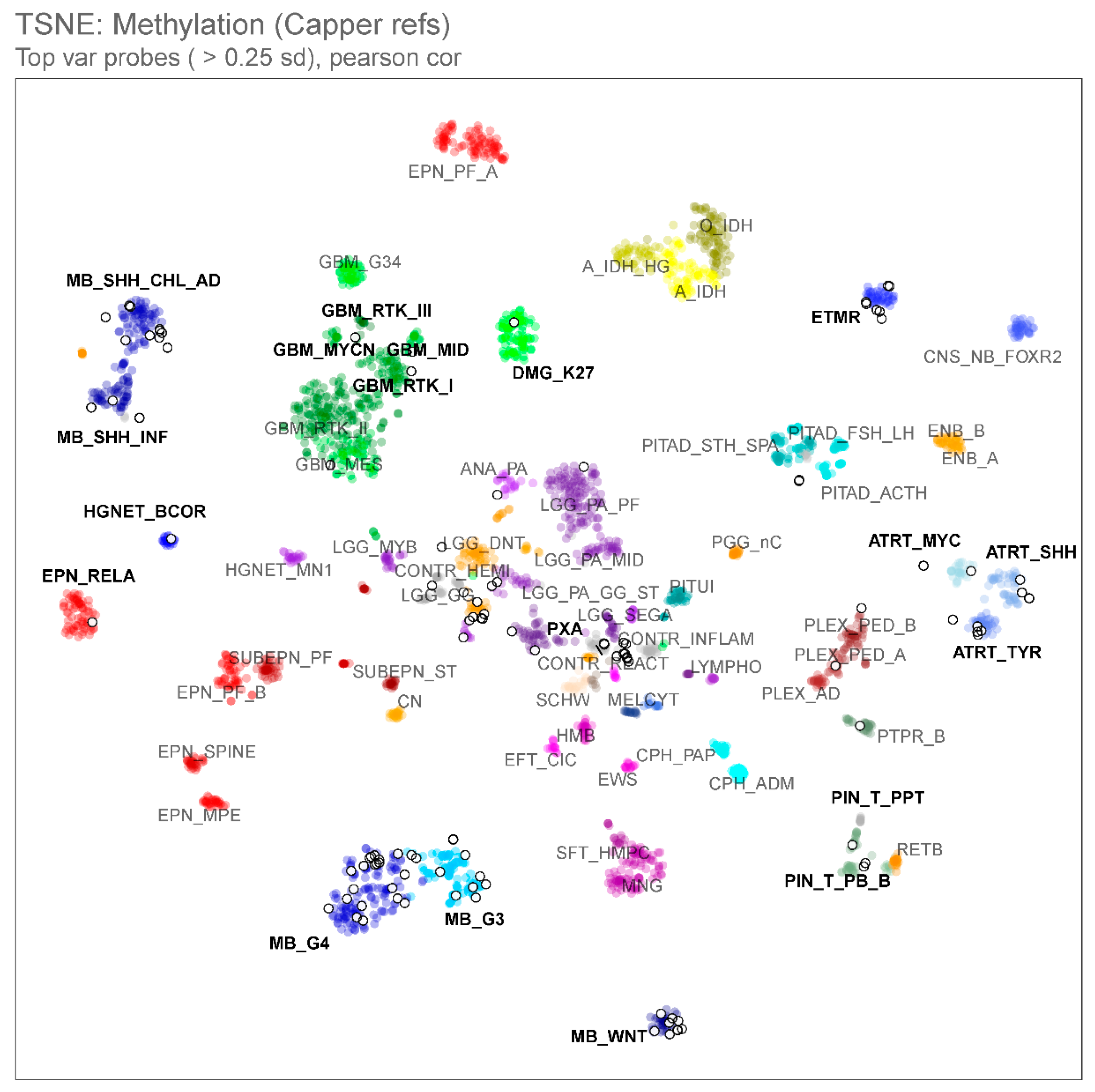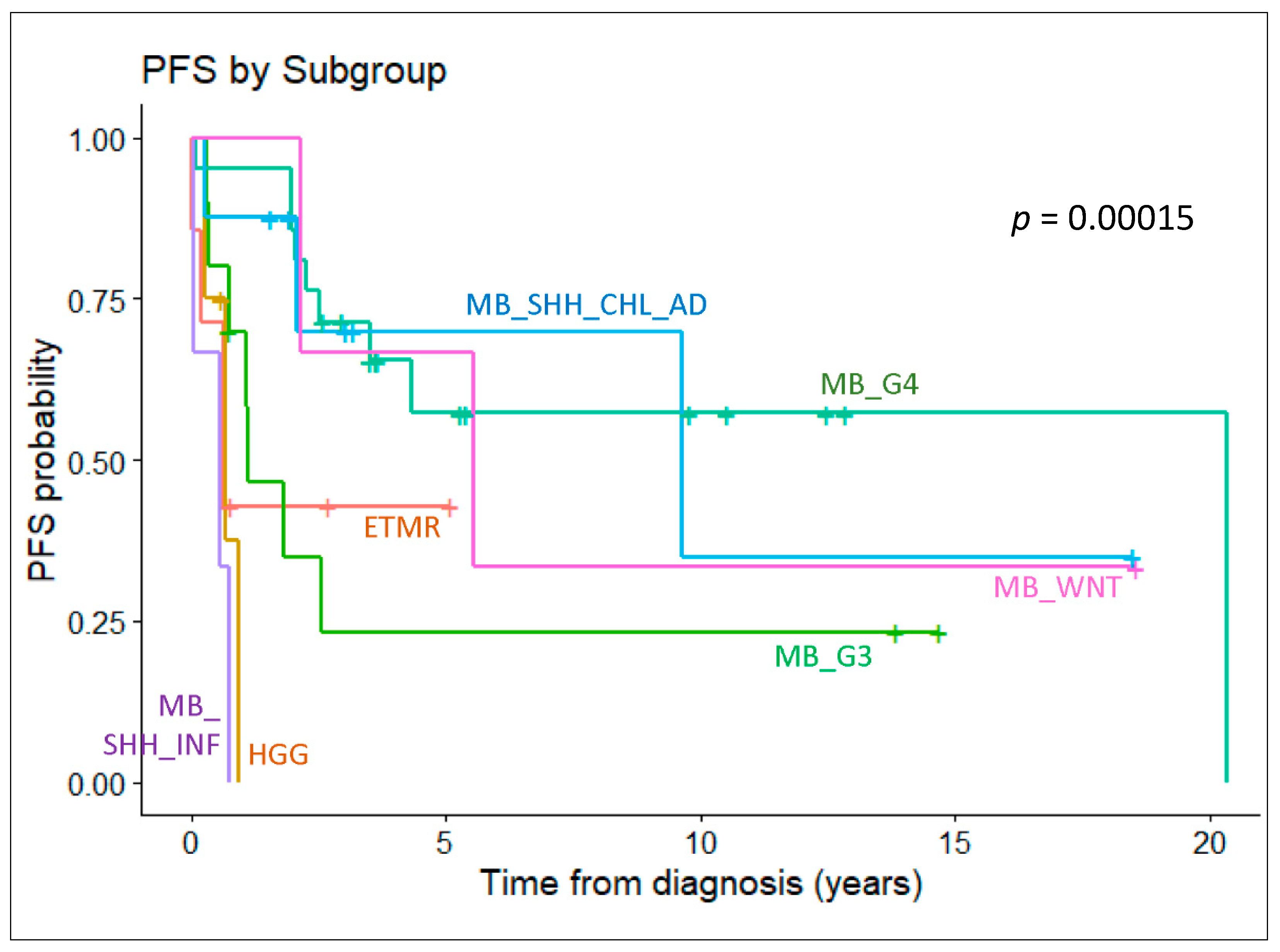Genome-Wide DNA Methylation Profiling as Frontline Diagnostics for Central Nervous System Embryonal Tumors in Hong Kong
Abstract
:Simple Summary
Abstract
1. Introduction
2. Materials and Methods
2.1. Inclusion Criteria
2.2. DNA Extraction and Methylation Profiling
2.3. Statistical Analysis
3. Results
3.1. Demographic and Clinical Features
3.2. Tumor Specimen and Quality Control
3.3. Histopathologic-Molecular Correlation and Clinical Utility
3.4. Methylation Profiling Unveils Novel Histologic-Molecular Entities
4. Discussion
5. Conclusions
Author Contributions
Funding
Institutional Review Board Statement
Informed Consent Statement
Data Availability Statement
Acknowledgments
Conflicts of Interest
References
- Ostrom, Q.T.; Cioffi, G.; Gittleman, H.; Patil, N.; Waite, K.; Kruchko, C.; Barnholtz-Sloan, J.S. CBTRUS Statistical Report: Primary Brain and Other Central Nervous System Tumors Diagnosed in the United States in 2012–2016. Neuro-Oncology 2019, 21 (Suppl. S5), v1–v100. [Google Scholar] [CrossRef] [PubMed]
- Smith, M.A.; Seibel, N.L.; Altekruse, S.F.; Ries, L.A.; Melbert, D.L.; O’Leary, M.; Smith, F.O.; Reaman, G.H. Outcomes for Children and Adolescents with Cancer: Challenges for the Twenty-First Century. J. Clin. Oncol. 2010, 28, 2625–2634. [Google Scholar] [CrossRef] [PubMed]
- Cacciotti, C.; Fleming, A.; Ramaswamy, V. Advances in the molecular classification of pediatric brain tumors: A guide to the galaxy. J. Pathol. 2020, 251, 249–261. [Google Scholar] [CrossRef] [PubMed]
- Louis, D.N.; Perry, A.; Reifenberger, G.; Von Deimling, A.; Figarella-Branger, D.; Cavenee, W.K.; Ohgaki, H.; Wiestler, O.D.; Kleihues, P.; Ellison, D.W. The 2016 World Health Organization Classification of Tumors of the Central Nervous System: A summary. Acta Neuropathol. 2016, 131, 803–820. [Google Scholar] [CrossRef] [PubMed]
- Kumar, R.; Liu, A.P.Y.; Orr, B.A.; Northcott, P.A.; Robinson, G.W. Advances in the classification of pediatric brain tumors through DNA methylation profiling: From research tool to frontline diagnostic. Cancer 2018, 124, 4168–4180. [Google Scholar] [CrossRef] [PubMed]
- Ellison, D.W.; Kocak, M.; Figarella-Branger, D.; Felice, G.; Catherine, G.; Pietsch, T.; Frappaz, D.; Massimino, M.; Grill, J.; Boyett, J.M.; et al. Histopathological grading of pediatric ependymoma: Reproducibility and clinical relevance in European trial cohorts. J. Negat. Results Biomed. 2011, 10, 7. [Google Scholar] [CrossRef] [PubMed]
- Kresbach, C.; Neyazi, S.; Schüller, U. Updates in the classification of ependymal neoplasms: The 2021 WHO Classification and beyond. Brain Pathol. 2022, 32, e13068. [Google Scholar] [CrossRef] [PubMed]
- Stucklin, A.S.G.; Ryall, S.; Fukuoka, K.; Zapotocky, M.; Lassaletta, A.; Li, C.; Bridge, T.; Kim, B.; Arnoldo, A.; Kowalski, P.E.; et al. Alterations in ALK/ROS1/NTRK/MET drive a group of infantile hemispheric gliomas. Nat. Commun. 2019, 10, 4343. [Google Scholar] [CrossRef] [PubMed]
- Schepke, E.; Löfgren, M.; Pietsch, T.; Bontell, T.O.; Kling, T.; Wenger, A.; Vega, S.F.; Danielsson, A.; Dosa, S.; Holm, S.; et al. DNA methylation profiling improves routine diagnosis of paediatric central nervous system tumours: A prospective population-based study. Neuropathol. Appl. Neurobiol. 2022, 48, e12838. [Google Scholar] [CrossRef] [PubMed]
- Priesterbach-Ackley, L.P.; Boldt, H.B.; Petersen, J.K.; Bervoets, N.; Scheie, D.; Ulhøi, B.P.; Gardberg, M.; Brännström, T.; Torp, S.H.; Aronica, E.; et al. Brain tumour diagnostics using a DNA methylation-based classifier as a diagnostic support tool. Neuropathol. Appl. Neurobiol. 2020, 46, 478–492. [Google Scholar] [CrossRef] [PubMed]
- Wong, M.; Mayoh, C.; Lau, L.M.S.; Khuong-Quang, D.-A.; Pinese, M.; Kumar, A.; Barahona, P.; Wilkie, E.E.; Sullivan, P.; Bowen-James, R.; et al. Whole genome, transcriptome and methylome profiling enhances actionable target discovery in high-risk pediatric cancer. Nat. Med. 2020, 26, 1742–1753. [Google Scholar] [CrossRef] [PubMed]
- Capper, D.; Jones, D.T.W.; Sill, M.; Hovestadt, V.; Schrimpf, D.; Sturm, D.; Koelsche, C.; Sahm, F.; Chavez, L.; Reuss, D.E.; et al. DNA methylation-based classification of central nervous system tumours. Nature 2018, 555, 469–474. [Google Scholar] [CrossRef] [PubMed]
- Liu, A.P.-Y.; Li, K.K.-W.; Chow, C.; Chan, S.; Leung, A.W.-K.; Shing, M.M.-K.; To, K.-F.; Chan, D.T.-M.; Chan, G.C.-F.; Ng, H.-K. Expanding the clinical and molecular spectrum of pituitary blastoma. Acta Neuropathol. 2022, 143, 415–417. [Google Scholar] [CrossRef] [PubMed]
- Louis, D.N.; Perry, A.; Wesseling, P.; Brat, D.J.; Cree, I.A.; Figarella-Branger, D.; Hawkins, C.; Ng, H.K.; Pfister, S.M.; Reifenberger, G.; et al. The 2021 WHO Classification of Tumors of the Central Nervous System: A summary. Neuro-Oncology 2021, 23, 1231–1251. [Google Scholar] [CrossRef] [PubMed]
- Hovestadt, V.; Remke, M.; Kool, M.; Pietsch, T.; Northcott, P.A.; Fischer, R.; Cavalli, F.M.G.; Ramaswamy, V.; Zapatka, M.; Reifenberger, G.; et al. Robust molecular subgrouping and copy-number profiling of medulloblastoma from small amounts of archival tumour material using high-density DNA methylation arrays. Acta Neuropathol. 2013, 125, 913–916. [Google Scholar] [CrossRef] [PubMed]
- Northcott, P.A.; Buchhalter, I.; Morrissy, A.S.; Hovestadt, V.; Weischenfeldt, J.; Ehrenberger, T.; Gröbner, S.; Segura-Wang, M.; Zichner, T.; Rudneva, V.A.; et al. The whole-genome landscape of medulloblastoma subtypes. Nature 2017, 547, 311–317. [Google Scholar] [CrossRef] [PubMed]
- Liu, A.P.Y.; Gudenas, B.; Lin, T.; Orr, B.A.; Klimo, P.; Kumar, R.; Bouffet, E.; Gururangan, S.; Crawford, J.R.; Kellie, S.J.; et al. Correction to: Risk-adapted therapy and biological heterogeneity in pineoblastoma: Integrated clinico-pathological analysis from the prospective, multi-center SJMB03 and SJYC07 trials. Acta Neuropathol. 2019, 139, 273–275. [Google Scholar] [CrossRef] [PubMed]
- Ho, B.; Johann, P.D.; Grabovska, Y.; Andrianteranagna, M.J.D.D.; Yao, F.; Frühwald, M.; Hasselblatt, M.; Bourdeaut, F.; Williamson, D.; Huang, A.; et al. Molecular subgrouping of atypical teratoid/rhabdoid tumors—A reinvestigation and current consensus. Neuro-Oncology 2019, 22, 613–624. [Google Scholar] [CrossRef] [PubMed]
- Orr, B.A. Pathology, diagnostics, and classification of medulloblastoma. Brain Pathol. 2020, 30, 664–678. [Google Scholar] [CrossRef] [PubMed]
- Liu, A.P.Y.; Liu, Q.; Shing, M.M.K.; Ku, D.T.L.; Fu, E.; Luk, C.-W.; Ling, S.-C.; Cheng, K.K.F.; Kwong, D.L.W.; Ho, W.W.S.; et al. Incidence and Outcomes of CNS Tumors in Chinese Children: Comparative Analysis with the Surveillance, Epidemiology, and End Results Program. JCO Glob. Oncol. 2020, 6, 704–721. [Google Scholar] [CrossRef] [PubMed]






| Entity | Subgroup | n |
|---|---|---|
| Total | 97 | |
| Medulloblastoma | 52 | |
| Wingless-activated | 8 | |
| Sonic hedgehog-activated (SHH) (infant) | 3 | |
| SHH (children/adult) | 10 | |
| Group 3 | 10 | |
| Group 4 | 21 | |
| Atypical teratoid/rhabdoid tumor | 9 | |
| TYR | 5 | |
| SHH | 3 | |
| MYC | 1 | |
| Pineal parenchymal tumors | 6 | |
| Pineoblastoma | 3 | |
| Pineal parenchymal tumor of intermediate differentiation | 2 | |
| Papillary tumor of pineal region | 1 | |
| Embryonal tumor with multi-layered rosettes | 7 | |
| Pituitary blastoma | 2 | |
| High-grade neuroepithelial tumor, BCOR-altered | 1 | |
| High-grade glioma | 4 | |
| Low-grade glioma/ganglioglioma | 1 | |
| Pleomorphic xanthastrocytoma | 1 | |
| Ependymoma, RELA-fusion positive | 1 | |
| Choroid plexus tumor | 1 | |
| Control | 2 | |
| No match | 10 |
Disclaimer/Publisher’s Note: The statements, opinions and data contained in all publications are solely those of the individual author(s) and contributor(s) and not of MDPI and/or the editor(s). MDPI and/or the editor(s) disclaim responsibility for any injury to people or property resulting from any ideas, methods, instructions or products referred to in the content. |
© 2023 by the authors. Licensee MDPI, Basel, Switzerland. This article is an open access article distributed under the terms and conditions of the Creative Commons Attribution (CC BY) license (https://creativecommons.org/licenses/by/4.0/).
Share and Cite
Tam, O.C.H.; Ho, R.S.L.; Chan, S.; Li, K.K.W.; Lam, T.-L.; Cheung, E.T.Y.; Cheung, O.-Y.; Ho, W.W.S.; Cheng, K.K.F.; Shing, M.M.K.; et al. Genome-Wide DNA Methylation Profiling as Frontline Diagnostics for Central Nervous System Embryonal Tumors in Hong Kong. Cancers 2023, 15, 4880. https://doi.org/10.3390/cancers15194880
Tam OCH, Ho RSL, Chan S, Li KKW, Lam T-L, Cheung ETY, Cheung O-Y, Ho WWS, Cheng KKF, Shing MMK, et al. Genome-Wide DNA Methylation Profiling as Frontline Diagnostics for Central Nervous System Embryonal Tumors in Hong Kong. Cancers. 2023; 15(19):4880. https://doi.org/10.3390/cancers15194880
Chicago/Turabian StyleTam, Otto C. H., Ronnie S. L. Ho, Shing Chan, Kay K. W. Li, Tit-Leung Lam, Elaine T. Y. Cheung, Oi-Yee Cheung, Wilson W. S. Ho, Kevin K. F. Cheng, Matthew M. K. Shing, and et al. 2023. "Genome-Wide DNA Methylation Profiling as Frontline Diagnostics for Central Nervous System Embryonal Tumors in Hong Kong" Cancers 15, no. 19: 4880. https://doi.org/10.3390/cancers15194880
APA StyleTam, O. C. H., Ho, R. S. L., Chan, S., Li, K. K. W., Lam, T.-L., Cheung, E. T. Y., Cheung, O.-Y., Ho, W. W. S., Cheng, K. K. F., Shing, M. M. K., Ku, D. T. L., Chung, B. H. Y., Yang, W., Chan, G. C. F., Ng, H.-K., & Liu, A. P. Y. (2023). Genome-Wide DNA Methylation Profiling as Frontline Diagnostics for Central Nervous System Embryonal Tumors in Hong Kong. Cancers, 15(19), 4880. https://doi.org/10.3390/cancers15194880







